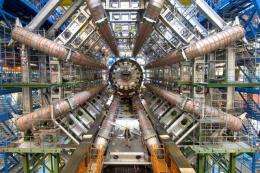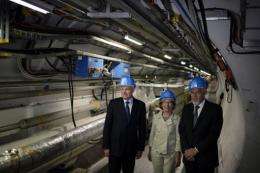New vigour in quest for Higgs boson

Heartened by a glimpse of what may be the Higgs boson, scientists at the CERN physics lab are smashing particles with new vigour in a quest to understand why matter has mass and other riddles of the natural universe.
Rather than the end of the line, the July 4 unveiling of a boson with Higgs-like characteristics opens new scientific frontiers, enthuse researchers at the Large Hadron Collider near Geneva.
The first step is to find irrefutable proof that the particle they found is indeed the Higgs -- known as the God Particle and believed to confer mass.
This would "open a fascinating new field of research", Higgs hunter Bernard Ille told AFP at the LHC, housed in a ring-shaped tunnel 27 kilometres (16.9 miles) long and up to 175 metres (568 feet) below ground.
A project of the European Organisation for Nuclear Research (CERN), the particle collider is employed in a needle-in-a-haystack quest for the Higgs boson and solving other riddles of particle physics.
"The LHC is made to last another twenty-odd years, exactly to allow us to immerse ourselves in this field of research, of which we have barely scratched the surface," said Ille, research director of France's CNRS institute.
Earlier this month, a 50-year search resulted in physicists announcing they found a particle "consistent" with the Higgs -- a milestone in Man's understanding of the natural world.
Confirming the existence of Higgs would validate the Standard Model of physics, a theory that identifies the building blocks of matter and the particles that convey fundamental forces.
The LHC comprises four huge labs along the Swiss-French border, two of which focus on the Higgs search -- CMS and Atlas.

The grand scale of the CMS, 15 metres in diameter and weighing 14,000 tons, contrasts sharply with the objects of its experiments -- the fundamental and smallest elements of all matter.
Hard to imagine when one is confronted by what appears to be a simple though very large tube, that inside beams of hydrogen protons can shoot at nearly the speed of light in a void similar to that found in outer space.
The CMS and its sister labs detect head-on collisions between the protons which then disintegrate into smaller particles.
The LHC can only be entered when it is in sleep mode, for risk of exposure to radiation emitted by the high-energy bursts.
The final prize for scientists involved in this quest: nothing less than Man's understanding of the Universe.
Today, physicists at the LHC are piling up collisions and statistics they hope will confirm the Higgs' existence and shed some light on its nature.
"Once we understand this, there are many other avenues that open up because the boson itself posed a serious theoretical problem," said Yves Sirois, one of the CMS' directors.
"Truly, it opens the door to a new level of physics" -- understanding such physics mind-benders as supersymmetry.
"It is likely that by raising the energy levels in the LHC in a few years we shall be capable of discovering dark matter," said Sirois.
Dark matter is believed to comprise 83 percent of matter in the Universe but cannot be detected by the naked eye.
The four LHC labs are used by some 10,000 scientists from around the world.
(c) 2012 AFP


















